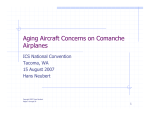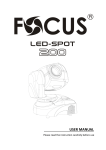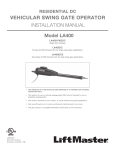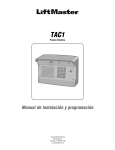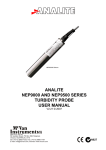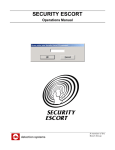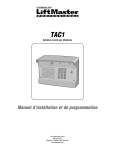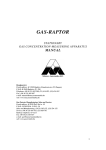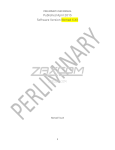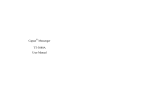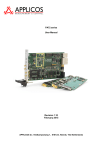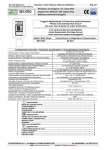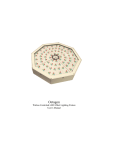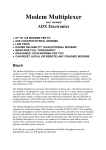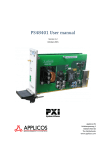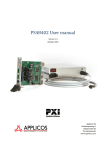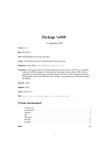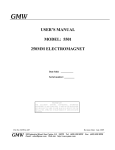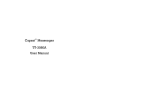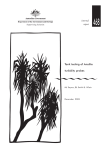Download synchrotac 706 series. data sheet and installation instructions
Transcript
Precision Weather Monitoring Instruments SYNCHROTAC 706 SERIES. DATA SHEET AND INSTALLATION INSTRUCTIONS Vers 4.51 © 2005 SYN706 Manual V4_51.indd abn 56 007 283 963 58 geddes street, Po box 298, Mulgrave Victoria, austraLIa, 3170 tel: (+61-3) 9582-7333, fax: (+61-3) 9560-1164 e-mail: [email protected], Internet: www.mcvan.com N827 Precision Weather Monitoring Instruments SYNCHROTAC 706 SERIES HEAVY DUTY WIND TRANSMITTER Synchrotac 706 Series Heavy Duty Wind Speed and Direction Transmitter Designed for general meteorological applications where accuracy, durability and long term reliability are required even in severe climatic conditions. The Synchrotac has a long history of reliable service in very aggresive environments such as in coastal tropical cyclone areas and oil rigs. Three anemometer models and two wind direction models are available in the Synchrotac 706 series. The anemometer models available are the 732 - poly-phase linear generator; the 734 - isolated switch contact closure; and the 736 for opto-electronic pulse output. The wind direction models may be either the 706 unit - 360° precision potentiometer or the 724 unit utilising a ganged 540° potentiometer assembly. The anemometer section may be purchased separately for wind speed only applications. Series 706 Heavy Duty Wind Speed and Direction Transmitter General Specifications The Synchrotac 706 Series Heavy Duty Wind Speed and Direction Transmiters are designed for long trouble free life under severe climatic conditions. They are solidly constructed from naval bronze, brass, stainless steel and other corrosion resistant materials. Bearings are low friction stainless steel for a low starting threshold. The instrument is sealed against dust, moisture and vermin ingress and mounts directly on a 3⁄4 inch (speed only) or 11⁄2 inch (speed & direction) male BSP thread. Special bearing lubricants ensure reliable operation over the temperature range and, under normal conditions, should give maintenance free operation in excess of 10 years. The wind speed section may be any one of three user selected technologies. The type 732 is a ten pole ac generator , the type 734 employs magnetically actuated reed switch(es) and the 736 is an opto-electronic transducer. Wind direction is also ordered in one of two different configurations. The type 706 is a potentiometric transducer, and the type 724 is a 540° configuration employing two precision potentiometers. Wind Speed Transmitter Section - General Cup Diameter 127mm (5”). Turning Circle Diameter 457mm (18”). Body Diameter 102mm (4”). Overall Height 229mm (9”). Mass of Cup Set 0.95kg. (2.1lbs). Overall Weight 3kg. (6.6lbs). Mounting 3⁄4” BSP Female Thread. Maximum Wind Speed >100m/sec (>200 knots) Accuracy Better than ±3% above 5m/sec. Transfer Coefficient 0.35 revs/meter Wind Direction Transmitter Section - General Vane Length 457mm (18”). Turning Circle Diameter 914mm (36”). Body Diameter 109mm (4.25”). Overall Height 329mm (13”). Mass of Vane Assembly 1.1kg. (2.4lbs). Overall Weight 9kg. (19.8lbs). Mounting 11⁄2” BSP Female Thread. Starting Threshold <0.7m/sec. Mechanical Travel 360° (continuous). Operating Temperature -40°C to +60°C. Type 732 Wind Speed Transducer Transducer Permanent magnet 10 pole ac generator. Signal Output 136mV/m/sec, and 1.8Hz/m/sec @>3m/sec. Starting Threshold <0.7 m/sec. Output Resistance 22 ohms nominal. Operating Temperature -40°C to +60°C. Type 706 Wind Direction Transducer Transducer 1 kΩ precision potentiometer. Electrical Travel Better than 354°. Max Transducer Voltage 12V dc continuous. Type 734 Wind Speed Transducer Transducer Magnetically actuated reed switch. Output Momentary contact closure. VER 1 single closure per cup set revolution, VER 2 five closures per cup set revolution. ON resistance 8.2 ohms nom. Starting Threshold <0.6 m/sec. Electrical Rating 48Vdc/30Vac, 0.3A max. Load must be non-inductive. Operating Temperature -40°C to +60°C. Type 736 Wind Speed Transducer Transducer Opto-electronic. Output From 1 to 30 pulses per cup set revolution either 5V or 1mA (to be specified at time of order). Starting Threshold <0.5 m/sec. Power Requirements 5.5 - 28V dc, 10mA max. Operating Temperature -20°C to +60°C. Type 724 Wind Direction Transducer Transducer Two 1 kΩ precision potentiometers ganged 180° apart. Electrical Travel 540°. Max Transducer Voltage 12V dc continuous. Combined Wind Speed and Direction Sections Overall Height 558mm (22”). Overall Weight 12kg. (26.4lbs) Ordering Information Wind Speed Only Order SYN732, SYN734 or SYN736 as required. For SYN734 specify VER1 or VER 2. Wind Speed & Direction Start with wind direction section and add wind speed section preceded by a slash. Example SYN706/732 Options Ordered separately. Specification subject to change without notice. SYN706 V9.indd, Nov 2003 INSTALLATION INSTRUCTIONS (full instrument - wind direction and wind speed). 1. 2. 3. Prepare a mast to appropriate height, with at least 250mm of pipe at top threaded to 1½” B.S.P. The male thread section must be at least 55mm long. Screw the supplied large brass locking nut onto the pipe thread to the bottom of the thread. Feed a suitable cable* with approximately 250mm protruding from the top of the mast pipe. Ensure that the mast pipe is properly earthed. Remove the Synchrotac 706 series wind speed and direction transmitter from its packing being careful not to damage the cup or vane assemblies. Remove the weather-proof 108mm diameter cover from the wind direction section by loosening the 3 screw located on its underside, and turning the cover so that the screw heads pass through the enlarged section of the slotted holes in the cover’s flange. Place the wind direction cover over and through the mast pipe so that the flange is at the bottom, and temporarily tie it to the mast until the unit is installed and wiring completed. Cable (shield trimmed back) 1.5” BSP Thread 15 - 10 mm 55mm Mast End Ma En Prepare mast end and cable Prepa an Cable Mast End Ma En Large Locking Nut 4. Thread the cable up through the B.S.P. female thread fitting at the base of the wind direction unit. Apply some slow setting thread adhesive to the mast thread and screw the instrument onto the mast. Use caution as the instrument is heavy 5. Bare (or fix male 6.4mm spade connectors to) the necessary number of conductors from the cable and connect to the terminals at the bottom of the wind direction cartridge keeping note of the colours. Connection can usually be done using a right-angled screwdriver; if this is not possible, remove the cartridge for connection as follows: Fit large looking nut Note carefully before the removal of the wind direction cartridge the position of all parts in relation to each other. Slacken the 4 set screws in the main frame that holds the direction cartridge in position, but only far enough to allow the clamp and direction cartridge to be lowered and removed. Place the direction cartridge clamp over the conductors (tapered sides to the bottom). Connect the conductors and prepare to re-install the cartridge in the same position as before. First note that both the gear and the direction cartridge have a 3mm hole in the top, and the clamp has a pin attached to it by means of wire. Rotate the gear on top of the wind direction cartridge so that it lines up with the hole in the top of the unit. Place the cartridge back in the frame of the unit, making sure that the rubber ring is in position at the bottom of the cartridge. The holes in the top of the cartridge and the gear should be opposite the small gear in the top of the wind direction unit. With the balance weight of the vane in the same position prior to cartridge removal, engage the gears. Place the cartridge clamp in position and tighten the 4 locking set screws in position so that the rubber ring just compresses. Ensure the cartridge is held firmly and will not move. 6. 3/4” BSP Thread Place the supplied 3mm right-angled pin in the hole in the cartridge gear. To enable this to be done you will note that to the side of a screw over which the conductors from the wind speed section is placed, there is a machined section the boss to allow the pin to be installed. Turn the wind direction vane until the pin locates in the hole in the top cartridge. This now locks the unit in the North position of the cartridge. Tighten the wind direction unit on the mast (using the 55mm spaced flats on the bottom mounting hub) and adjust until the vane balance weight points to the North. Lock the unit in position using the set screw in the threaded portion at the base of the unit. Remove the 3mm pin so that the vane is free to rotate and let the pin hang down inside the mounting pipe, making sure that it does not touch the connection terminals. Screw up the brass locking nut and firmly tighten against the anemometer housing – ensure the housing does not rotate. Fit ma pi 7. Fasten the locking set screw in the base of the wind direction casting onto the mast pipe thread. 8. Connect the appropriate conductors to the wind speed terminal strip mounted near the bottom of the main frame. Ensure there is a good earthing contact between the instrument body and the mast pipe. 9. Replace the weatherproof cover on the unit and tighten the 3 screws. Rotate the vane and make sure it moves freely. 10. Fit the cup set assembly to the anemometer shaft. The cup set hub is supplied with two M5 set screws. Ensure the set screw in the cup set hub is in line with the flat on the anemometer shaft and seated in the circular depression on the shaft. Firmly tighten the first set screw. Screw in the second set screw and tighten. If the cup hub and the shaft are properly aligned the end of the second grubscrew will be just below the surface of the cup hub. Apply a little thread adhesive to the thread of the second setscrew. 11. Test the unit for proper peformance. Ensure there is a good earthing contact between the instrument body and the mast pipe. 12. If properly installed, the Synchrotac 706 series wind speed and direction transmitter should require no maintenance for many years. * The characteristics of a suitable cable is dependant on the instrument used and the application environment. As a minimum the cable should contain at least 2 cores for the SYN732 and 734, 3 cores for the SYN736, 5 cores for the SYN706/732 and SYN706/734 and 6 cores for the SYN706/ 736 although a few spare cores is recommended. The conductor core should be overall shielded with the shield terminated at the logger/indicator end only. The cable should be a low capacitive type particularly for installations containing the SYN734 anemometer version. High cable capacitance can shorten the life of the reed switch units in the SYN734 due to the high current discharge it may cause each time the switch closes - a limiting resistor is installed in the SYN734 to assist in the protection of the reed switches contained therein. SAFETY NOTE: To ensure the instrument remains properly installed in service make sure a suitable and quality thread adhesive is used where stipulated. Failure to do so may result in the instrument or on of its components working loose under conditions of prolonged thermal or mechanical stress. Screw on locking nut before fitting anemometer to the pipe. Tighten locking nut against the anemometer base once it has been fitted and aligned. DATE B 78/96 1/4/96 C 80/02 13/8/02 D 58/03 26/6/03 IS. C/N Mounting Pipe with male 1.5" BSP Thread x 55mm (by others) Pass cable through mounting pipe and into housing. Locking Set Screw 55mm spaced flats for tightening and aligning to mast. Wind Speed Terminals Wind Direction Terminals Mainframe Housing Casting Fuse 63mA 2 1kohms W 3 CCW Unless otherwise stated. Lin ±0.2mm, Ang ±0.5°. Tolerances: Output AC2 or SW2 DC Supply DRN JVdV APP KH P Status 25/3/96 SHEET SCALE DWG No. ISS D 3285 25/3/96 1 OF 1 NTS SYNCHROTAC 706 INSTALLATION TERMINATION DETAILS 2002 C Copyright SYN736 Anemometer section SYN732 and SYN734 Anemometer section File: SYN706 Termination Details.cdr Common Red Blue White Black AC1 or SW1 Blue DIRECTION CARTRIDGE LOOKING AT BASE 1 CW INSTALLATION INSTRUCTIONS (anemometer section only - SYN732/734/736). 1. Prepare a mast to appropriate height, with at least 250mm of Cable (shield trimmed pipe at top threaded to 3/4” B.S.P. The male thread section 1.5” BSP back) Thread must be at least 20mm long. Feed a suitable cable* with 55mm the top of the mast pipe. approximately 250mm protruding from Ensure that the mast pipe is properly earthed. Mast End 2. Remove the anemometer body and cup set assembly from its packing being careful not to damage the cup set assembly. 3. and cable Remove the mating female connector and put aside. Separate the bottom half of the 3/4” union at the base of the Cable a anemometer body and tightly fit it to the mast pipe, using thread adhesive. Ensure the cable is threaded through the union base. Prepare mast end 4. The mating female connector should be properly terminated to Mast the cable protruding from the top of the mastEndpipe. 5. Mate the female connector into the plug at the base ofLocking Nut Fit large lookingthe the anemometer body. Care should be taken to ensure nut connectors are properly mated. The pins are numbered and keyed. Large Cable (shield trimmed back) 3/4” BSP Thread 15 - 10 mm Mast End Prepare mast end and cable Cable Mast End Male Union Piece Fit male union piece 6. Apply some (breakable) thread adhesive to the male union thread. Place the anemometer body onto its mating union half on the mast and fasten the union nut tightly. Fasten the M5 hex set screw in the union nut. 7. Fit the cup set assembly to the anemometer shaft. The cup set hub is supplied with two M5 set screws. Ensure the set screw in the cup set hub is in line with the flat on the anemometer shaft and seated in the circular depression on the shaft. Firmly tighten the first set screw. Apply a little (breakable) thread adhesive to the thread of the second setscrew, insert behind the first set screw and tighten. If the cup hub and the shaft are properly aligned the end of the second grubscrew will be just below the surface of the cup hub. 8. Test the anemometer for proper peformance. Ensure there is a good earthing contact between the anemometer body and the mast pipe. 9. If properly installed, the Synchrotac 706 series wind speed transmitter should require no maintenance for many years. * The characteristics of a suitable cable is dependant on the instrument used and the application environment. As a minimum the cable should contain at least 2 cores for the SYN732 and 734, 3 cores for the SYN736, 5 cores for the SYN706/732 and SYN706/734 and 6 cores for the SYN706/ 736 although a few spare cores is recommended. The conductor core should be overall shielded with the shield terminated at the logger/indicator end only. The cable should be a low capacitive type particularly for installations containing the SYN734 anemometer version. High cable capacitance can shorten the life of the reed switch units in the SYN734 due to the high current discharge it may cause each time the switch closes - a limiting resistor is installed in the SYN734 to assist in the protection of the reed switches contained therein. SAFETY NOTE: To ensure the instrument remains properly installed in service make sure a suitable and quality thread adhesive is used where stipulated. Failure to do so may result in the instrument or on of its components working loose under conditions of prolonged thermal or mechanical stress. Note: Reed switch life can be adversely affected by long cable runs due to cable capacitance and inductive loads. Use low capacitance cable where ever possible and ensure the end load is resistive. VER 2 (5 switches) IS C/N Reed Switch 50V ac/dc rating 0.5Amp non-inductive. DATE Unless otherwise stated. Lin ±0.5mm Ang±0.5°Ang Tolerances VER 1 (one switch only) 2 2 3 24/11/03 SHEET 1 OF 1 C SCALE DWG No ISS NTS A TBA © 2003 Viewed looking at the base of the Anemometer 1 Status MAX 48V dc MAX 30V ac MAX 0.3Amp 1 Connector at base of anemometer Sw2 MOV S10K30 SYN734 Anemometer Circuit Schematic DRN KH APP 8.2 ohms 1 watt WW Sw1 Precision Weather Monitoring Instruments APPLICATION NOTE Positioning of Wind Speed Instruments The World Meteorological Organisation (WMO) states that an anemometer for the purpose of measuring surface winds should be mounted 10 metres above the ground as a standard. Ideally, measurements should be made on level, open terrain, but since such conditions rarely exist, certain guide-lines may be followed should obstructions or other problems related to exposure exist. Locating Instruments on or near Structures Generally accepted guide-lines for locating wind systems around an obstruction while keeping instruments in the ambient airflow. 1. • • • For structures up to 10 metres in height. Locate instrument generally upwind of a structure at a distance away equal to the structure’s height. Locate instrument on top of the structure at a height of the structure above the structure. Locate instrument a distance generally downwind of structure equal to 5-10 times the structure height. 2. • • For structures in excess of 10 metres height. Placing instruments on top of very small structures presents some difficulties. Whenever possible it is best to erect a tower to clear any obstructions. In the case of a building where a tower may not be practical, an alternative is to place the instrument on a corner of the building that is generally upwind, or the corner, which is exposed to the frequency of the wind. Before making a permanent installation monitor a small flag at the end of a pole mounted in various locations on the building, to assist in determining the location which is most representative. In a flat open rural area an installation of 2 metres height may be sufficient. File: Wind Application Note 1.doc abn 56 007 283 963 58 geddes street, Po box 298, Mulgrave Victoria, austraLIa, 3170 tel: (+61-3) 9582-7333, fax: (+61-3) 9560-1164 e-mail: [email protected], Internet: www.mcvan.com EC Declaration of Conformity according to Council Directive 89/336/EEC We, McVan Instruments Pty Ltd, declare under our sole responsibility that the productS: SYNCHROTAC 706 SERIES WIND INSTRUMENTS SYN732, SYN734V1, SYN734V2, SYN736 SYN706/732, SYN706/734V1, SYN706/734V2, SYN706/736 SYN724/732, SYN724/734V1, SYN724/734V2, SYN724/736 Manufactured by: McVan Instruments Pty Ltd To which this declaration relates, are in conformity with the protection requirements of council directives 89/336/eec on the approximation of the laws relating to electromagnetic compatibly. This Declaration of Conformity is based upon compliance of the product with the following harmonised standards: Emissions:EN50081-1 using EN55022 class B. Immunity:EN50082-1 using IEC61000-4-2, IEC61000-4-3, IEC61000-4-4 and IEC61000-4-6. Signed by: John Van de Vreede – Director. Date of Issue: 1 DECEMBER 2003. Place of Issue: McVan Instruments Pty Ltd 58 Geddes Street, Mulgrave Vic. 3170 Australia. abn 56 007 283 963 58 geddes street, Po box 298, Mulgrave Victoria, austraLIa, 3170 tel: (+61-3) 9582-7333, fax: (+61-3) 9560-1164 e-mail: [email protected], Internet: www.mcvan.com N827 NOTES abn 56 007 283 963 58 geddes street, Po box 298, Mulgrave Victoria, austraLIa, 3170 tel: (+61-3) 9582-7333, fax: (+61-3) 9560-1164 e-mail: [email protected], Internet: www.mcvan.com
















